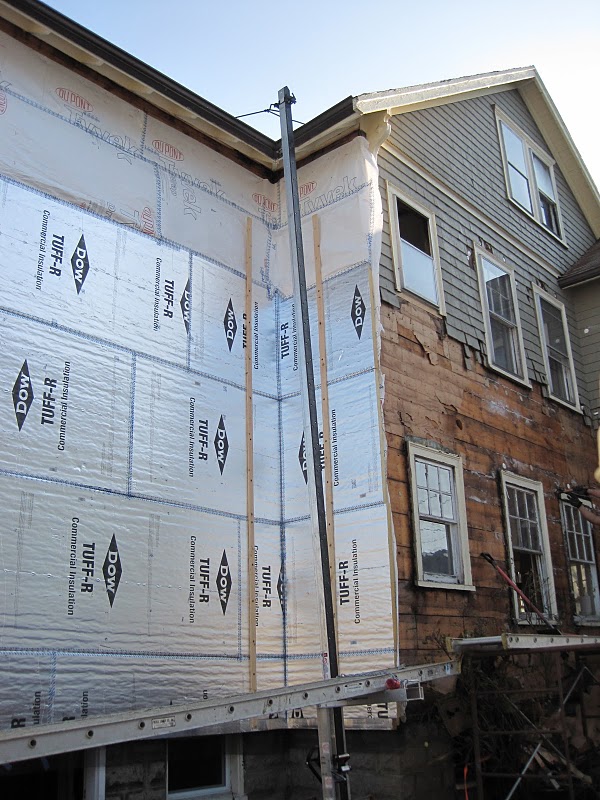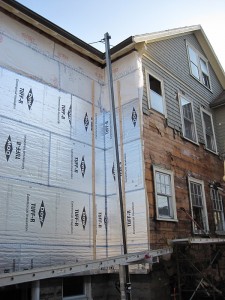This post continues the sharing of learning from the “deep energy retrofit” of our home. It summarizes a financial analysis of the project. The full analysis is contained in this spreadsheet.
Here are the financial takeaways from the spreadsheet from a homeowner perspective:
- If you haven’t blown cellulose into the walls of your house, insulated your foundation walls and done a general air sealing, go out and do it. Bringing insulation up to code pays back fast and handsomely under any reasonable assumptions about energy prices and the economy. The cost depends on the home, but is likely to be well under $30,000 for a very solid project.
- If your cost of borrowing is low (we used a first mortgage with a rate 4.25%), solar hot water also pays back well with very modest inflation assumptions about natural gas prices (1.5%), even before the tax incentives. With the 30% federal tax credit, this component pays back even if natural gas prices stay flat.
- At current prices, solar photovoltaic cells are financially cost-effective only if substantial incentives are available. The same appears to be true of insulation going well beyond code (in our case, wrapping the house in foam paneling installed under new siding). These steps are, however, cost-effective on their own if you assume that energy prices are going to rise steadily (5% or more for the next few decades).
- The tax and power-resale incentives make solar photovoltaic cost-effective if your home has a suitable panel location.
- If you want to go far beyond code in insulating your home, seek to participate in a utility-based grant program. The one that we participated in was National Grid’s Deep Energy Retrofit Program. You’ll need a substantial grant — covering half or more of the added insulation cost — to make the project cost-effective at current energy prices. Additionally, participation in a DER program will give you a lot of comfort in the project — you’ll get a lot of support and oversight.
- Don’t expect a utility grant to make a project that you are undertaking for maintenance reasons less expensive. The high insulation standards required in a DER program may be expensive to implement and the grant will probably not cover the upfront cost of the additional insulation. And to make the additional insulation feasible, you may need to go further than you otherwise would in maintenance, e.g., replacing siding and roofing.
- In the absence of a workable utility DER grant, consider a “light” version of the DER. In our case, the DER grant terms required R-40 insulation on the walls and R-60 on the roof. That meant four inches of foam applied around the exterior walls under the siding and six inches on the roof under the nail-base for the shingles. A single layer of 2″ foam would have achieved roughly 80% of the marginal energy-savings of the foam wrap at less than half of the cost.
- If you are considering going beyond code insulation, do invest in a blower door test of your air seal and get some quality energy modeling of your home to project what the costs and benefits of your project will be. The estimating technology is getting better and better. A blower door test is also a great quality control tool.
The spreadsheet also explores the carbon foot print reduction benefits of the project — attempting to use estimates of the social cost of carbon and other forms of pollution to see how the project works from a larger social cost-benefit standpoint. In a nutshell, the social benefit computations, even loaded generously, do not alter the financial analysis — meeting code insulation stands out as very desirable to do; the other project components are closer calls. They offer real and tangible benefits in terms of carbon reduction, but there may be less expensive ways to help the planet.
Of course, in making decisions about undertaking a deep energy retrofit project, a homeowner should consider harder-to-quantify benefits like comfort, air quality, durability and noise reduction. It’s also very desirable to be substantially protected from rising energy prices. Finally, each DER that gets done at this early stage is an experiment that makes a contribution to building science.
For more background on the project , please see these previous posts:



Update on March 15, 2011: Had a very helpful conversation today with energy efficiency consultant, Michael Blasnick, who was kind enough to review the analysis in this post and the attached spreadsheet.
The main thrust of his comments was that the savings from the code insulation step of the project were overstated in the analysis in three ways: (1) we used as a baseline a counter-factual scenario — an occupied attic and basement with zero insulation; (2) we used the REM rate model which overstates heat loss in uninsulated buildings (further inflating the energy consumption baseline); (3) we entered the heating plant change into the analysis last, which results in heating consumption savings being based on an inefficient plant.
These over-estimations are not sufficient to change the conclusions of the analysis, with which Mr. Blasnick agreed: the code insulation steps are highly cost-effective; the additional insulation steps depend on subsidies to make them cost-effective, even when social costs of carbon are included.
Mr. Blasnick also identified a small error in the solar hot-water cost-benefit computation which I have fixed in the spreadsheet.